
Diazoxide
描述
Diazoxide is a non-diuretic benzothiadiazine derivative that is primarily used to manage hypoglycemia due to hyperinsulinism. It is chemically related to thiazide diuretics but does not inhibit carbonic anhydrase and lacks chloriuretic or natriuretic activity . This compound is known for its ability to activate ATP-sensitive potassium channels, which helps in inhibiting insulin release .
作用机制
二氮嗪通过激活胰腺β细胞中的 ATP 敏感性钾通道发挥作用。这种激活导致钾通道开放,导致细胞膜超极化。 因此,钙离子内流减少,从而抑制胰岛素释放 。 这种机制与磺酰脲类药物相反,后者会增加胰岛素释放 .
生化分析
Biochemical Properties
Diazoxide activates ATP-sensitive potassium channels . This activation leads to the hyperpolarization of cell membranes, which in turn inhibits the release of insulin . This biochemical property makes this compound particularly useful in the treatment of hyperinsulinemic hypoglycemia .
Cellular Effects
This compound has a significant impact on various types of cells and cellular processes. It influences cell function by inhibiting insulin release . This inhibition can affect cell signaling pathways, gene expression, and cellular metabolism . This compound also exhibits hypotensive activity and reduces arteriolar smooth muscle and vascular resistance .
Molecular Mechanism
This compound works by binding to the sulfonylurea receptor (SUR) subunit of the ATP-sensitive potassium channel (K ATP) channel on the membrane of pancreatic beta‐cells . This binding promotes a potassium efflux from beta-cells, leading to the inhibition of insulin release .
Temporal Effects in Laboratory Settings
The effects of this compound can change over time in laboratory settings. The plasma half-life of this compound varies from 9.5 to 24 hours in children with normal renal function and from 20 to 72 hours in adults with normal renal function . This indicates that the product’s stability and degradation, as well as any long-term effects on cellular function, need to be considered in both in vitro and in vivo studies .
Metabolic Pathways
This compound is metabolized in the liver through oxidation of the 3-methyl group, producing hydroxymethyl (MI) and carboxy (M2) derivatives . The MI derivatives undergo subsequent sulphate conjugation . It is estimated that, in subjects with normal renal function, 54-60% of this compound is metabolized .
Subcellular Localization
This compound is known to affect mitochondrial bioenergetics by opening the mKATP channel This suggests that this compound may be localized in the mitochondria of cells
准备方法
二氮嗪的制备涉及多种合成路线。一种常用的方法包括使邻氨基苯磺酰胺与 N-氯代琥珀酰亚胺在氯溶剂中反应,得到 2-氨基-5-氯苯磺酰胺。 然后将该中间体与咪唑盐和酰胺溶剂混合,然后加热得到二氮嗪 。 该方法避免了使用强腐蚀性和有毒试剂,使其更适合工业生产 .
化学反应分析
二氮嗪会发生各种化学反应,包括:
氧化: 二氮嗪在特定条件下可以被氧化,尽管详细的途径不太常见。
还原: 关于二氮嗪的还原反应鲜有报道。
科学研究应用
二氮嗪在科学研究中具有广泛的应用:
化学: 用于各种合成途径,以及多组分反应中的试剂.
生物学: 研究其对细胞钾通道的影响及其在调节细胞活性中的作用。
医学: 主要用于通过抑制胰岛素释放来治疗高胰岛素血症性低血糖。
工业: 用于生产药物,以及作为药物开发中的研究工具。
相似化合物的比较
二氮嗪在化学上与噻嗪类利尿剂相似,但不同之处在于它不具有利尿活性。类似的化合物包括:
噻嗪类利尿剂: 如氢氯噻嗪,用于治疗高血压和水肿,但作用机制不同。
磺酰脲类药物: 如格列本脲,会增加胰岛素释放,用于治疗 2 型糖尿病。二氮嗪具有独特的抑制胰岛素释放而不具备利尿活性的能力,这使其有别于这些类似化合物.
属性
IUPAC Name |
7-chloro-3-methyl-4H-1λ6,2,4-benzothiadiazine 1,1-dioxide | |
|---|---|---|
| Source | PubChem | |
| URL | https://pubchem.ncbi.nlm.nih.gov | |
| Description | Data deposited in or computed by PubChem | |
InChI |
InChI=1S/C8H7ClN2O2S/c1-5-10-7-3-2-6(9)4-8(7)14(12,13)11-5/h2-4H,1H3,(H,10,11) | |
| Source | PubChem | |
| URL | https://pubchem.ncbi.nlm.nih.gov | |
| Description | Data deposited in or computed by PubChem | |
InChI Key |
GDLBFKVLRPITMI-UHFFFAOYSA-N | |
| Source | PubChem | |
| URL | https://pubchem.ncbi.nlm.nih.gov | |
| Description | Data deposited in or computed by PubChem | |
Canonical SMILES |
CC1=NS(=O)(=O)C2=C(N1)C=CC(=C2)Cl | |
| Source | PubChem | |
| URL | https://pubchem.ncbi.nlm.nih.gov | |
| Description | Data deposited in or computed by PubChem | |
Molecular Formula |
C8H7ClN2O2S | |
| Source | PubChem | |
| URL | https://pubchem.ncbi.nlm.nih.gov | |
| Description | Data deposited in or computed by PubChem | |
DSSTOX Substance ID |
DTXSID7022914 | |
| Record name | Diazoxide | |
| Source | EPA DSSTox | |
| URL | https://comptox.epa.gov/dashboard/DTXSID7022914 | |
| Description | DSSTox provides a high quality public chemistry resource for supporting improved predictive toxicology. | |
Molecular Weight |
230.67 g/mol | |
| Source | PubChem | |
| URL | https://pubchem.ncbi.nlm.nih.gov | |
| Description | Data deposited in or computed by PubChem | |
Physical Description |
Solid | |
| Record name | Diazoxide | |
| Source | Human Metabolome Database (HMDB) | |
| URL | http://www.hmdb.ca/metabolites/HMDB0015251 | |
| Description | The Human Metabolome Database (HMDB) is a freely available electronic database containing detailed information about small molecule metabolites found in the human body. | |
| Explanation | HMDB is offered to the public as a freely available resource. Use and re-distribution of the data, in whole or in part, for commercial purposes requires explicit permission of the authors and explicit acknowledgment of the source material (HMDB) and the original publication (see the HMDB citing page). We ask that users who download significant portions of the database cite the HMDB paper in any resulting publications. | |
Solubility |
5.52e-01 g/L | |
| Record name | Diazoxide | |
| Source | DrugBank | |
| URL | https://www.drugbank.ca/drugs/DB01119 | |
| Description | The DrugBank database is a unique bioinformatics and cheminformatics resource that combines detailed drug (i.e. chemical, pharmacological and pharmaceutical) data with comprehensive drug target (i.e. sequence, structure, and pathway) information. | |
| Explanation | Creative Common's Attribution-NonCommercial 4.0 International License (http://creativecommons.org/licenses/by-nc/4.0/legalcode) | |
| Record name | Diazoxide | |
| Source | Human Metabolome Database (HMDB) | |
| URL | http://www.hmdb.ca/metabolites/HMDB0015251 | |
| Description | The Human Metabolome Database (HMDB) is a freely available electronic database containing detailed information about small molecule metabolites found in the human body. | |
| Explanation | HMDB is offered to the public as a freely available resource. Use and re-distribution of the data, in whole or in part, for commercial purposes requires explicit permission of the authors and explicit acknowledgment of the source material (HMDB) and the original publication (see the HMDB citing page). We ask that users who download significant portions of the database cite the HMDB paper in any resulting publications. | |
Mechanism of Action |
Diazoxide inhibits insulin release from the pancreas, by opening potassium channels in the beta cell membrane. Diazoxide is chemically related to thiazide diuretics but does not inhibit carbonic anhydrase and does not have chloriuretic or natriuretic activity. It also exhibits hypotensive activity by reducing arteriolar smooth muscle and vascular resistance. | |
| Record name | Diazoxide | |
| Source | DrugBank | |
| URL | https://www.drugbank.ca/drugs/DB01119 | |
| Description | The DrugBank database is a unique bioinformatics and cheminformatics resource that combines detailed drug (i.e. chemical, pharmacological and pharmaceutical) data with comprehensive drug target (i.e. sequence, structure, and pathway) information. | |
| Explanation | Creative Common's Attribution-NonCommercial 4.0 International License (http://creativecommons.org/licenses/by-nc/4.0/legalcode) | |
CAS No. |
364-98-7 | |
| Record name | Diazoxide | |
| Source | CAS Common Chemistry | |
| URL | https://commonchemistry.cas.org/detail?cas_rn=364-98-7 | |
| Description | CAS Common Chemistry is an open community resource for accessing chemical information. Nearly 500,000 chemical substances from CAS REGISTRY cover areas of community interest, including common and frequently regulated chemicals, and those relevant to high school and undergraduate chemistry classes. This chemical information, curated by our expert scientists, is provided in alignment with our mission as a division of the American Chemical Society. | |
| Explanation | The data from CAS Common Chemistry is provided under a CC-BY-NC 4.0 license, unless otherwise stated. | |
| Record name | Diazoxide [USAN:USP:INN:BAN:JAN] | |
| Source | ChemIDplus | |
| URL | https://pubchem.ncbi.nlm.nih.gov/substance/?source=chemidplus&sourceid=0000364987 | |
| Description | ChemIDplus is a free, web search system that provides access to the structure and nomenclature authority files used for the identification of chemical substances cited in National Library of Medicine (NLM) databases, including the TOXNET system. | |
| Record name | Diazoxide | |
| Source | DrugBank | |
| URL | https://www.drugbank.ca/drugs/DB01119 | |
| Description | The DrugBank database is a unique bioinformatics and cheminformatics resource that combines detailed drug (i.e. chemical, pharmacological and pharmaceutical) data with comprehensive drug target (i.e. sequence, structure, and pathway) information. | |
| Explanation | Creative Common's Attribution-NonCommercial 4.0 International License (http://creativecommons.org/licenses/by-nc/4.0/legalcode) | |
| Record name | diazoxide | |
| Source | DTP/NCI | |
| URL | https://dtp.cancer.gov/dtpstandard/servlet/dwindex?searchtype=NSC&outputformat=html&searchlist=759574 | |
| Description | The NCI Development Therapeutics Program (DTP) provides services and resources to the academic and private-sector research communities worldwide to facilitate the discovery and development of new cancer therapeutic agents. | |
| Explanation | Unless otherwise indicated, all text within NCI products is free of copyright and may be reused without our permission. Credit the National Cancer Institute as the source. | |
| Record name | diazoxide | |
| Source | DTP/NCI | |
| URL | https://dtp.cancer.gov/dtpstandard/servlet/dwindex?searchtype=NSC&outputformat=html&searchlist=76130 | |
| Description | The NCI Development Therapeutics Program (DTP) provides services and resources to the academic and private-sector research communities worldwide to facilitate the discovery and development of new cancer therapeutic agents. | |
| Explanation | Unless otherwise indicated, all text within NCI products is free of copyright and may be reused without our permission. Credit the National Cancer Institute as the source. | |
| Record name | diazoxide | |
| Source | DTP/NCI | |
| URL | https://dtp.cancer.gov/dtpstandard/servlet/dwindex?searchtype=NSC&outputformat=html&searchlist=64198 | |
| Description | The NCI Development Therapeutics Program (DTP) provides services and resources to the academic and private-sector research communities worldwide to facilitate the discovery and development of new cancer therapeutic agents. | |
| Explanation | Unless otherwise indicated, all text within NCI products is free of copyright and may be reused without our permission. Credit the National Cancer Institute as the source. | |
| Record name | Diazoxide | |
| Source | EPA DSSTox | |
| URL | https://comptox.epa.gov/dashboard/DTXSID7022914 | |
| Description | DSSTox provides a high quality public chemistry resource for supporting improved predictive toxicology. | |
| Record name | Diazoxide | |
| Source | European Chemicals Agency (ECHA) | |
| URL | https://echa.europa.eu/substance-information/-/substanceinfo/100.006.063 | |
| Description | The European Chemicals Agency (ECHA) is an agency of the European Union which is the driving force among regulatory authorities in implementing the EU's groundbreaking chemicals legislation for the benefit of human health and the environment as well as for innovation and competitiveness. | |
| Explanation | Use of the information, documents and data from the ECHA website is subject to the terms and conditions of this Legal Notice, and subject to other binding limitations provided for under applicable law, the information, documents and data made available on the ECHA website may be reproduced, distributed and/or used, totally or in part, for non-commercial purposes provided that ECHA is acknowledged as the source: "Source: European Chemicals Agency, http://echa.europa.eu/". Such acknowledgement must be included in each copy of the material. ECHA permits and encourages organisations and individuals to create links to the ECHA website under the following cumulative conditions: Links can only be made to webpages that provide a link to the Legal Notice page. | |
| Record name | DIAZOXIDE | |
| Source | FDA Global Substance Registration System (GSRS) | |
| URL | https://gsrs.ncats.nih.gov/ginas/app/beta/substances/O5CB12L4FN | |
| Description | The FDA Global Substance Registration System (GSRS) enables the efficient and accurate exchange of information on what substances are in regulated products. Instead of relying on names, which vary across regulatory domains, countries, and regions, the GSRS knowledge base makes it possible for substances to be defined by standardized, scientific descriptions. | |
| Explanation | Unless otherwise noted, the contents of the FDA website (www.fda.gov), both text and graphics, are not copyrighted. They are in the public domain and may be republished, reprinted and otherwise used freely by anyone without the need to obtain permission from FDA. Credit to the U.S. Food and Drug Administration as the source is appreciated but not required. | |
| Record name | Diazoxide | |
| Source | Human Metabolome Database (HMDB) | |
| URL | http://www.hmdb.ca/metabolites/HMDB0015251 | |
| Description | The Human Metabolome Database (HMDB) is a freely available electronic database containing detailed information about small molecule metabolites found in the human body. | |
| Explanation | HMDB is offered to the public as a freely available resource. Use and re-distribution of the data, in whole or in part, for commercial purposes requires explicit permission of the authors and explicit acknowledgment of the source material (HMDB) and the original publication (see the HMDB citing page). We ask that users who download significant portions of the database cite the HMDB paper in any resulting publications. | |
Melting Point |
330.5 °C | |
| Record name | Diazoxide | |
| Source | DrugBank | |
| URL | https://www.drugbank.ca/drugs/DB01119 | |
| Description | The DrugBank database is a unique bioinformatics and cheminformatics resource that combines detailed drug (i.e. chemical, pharmacological and pharmaceutical) data with comprehensive drug target (i.e. sequence, structure, and pathway) information. | |
| Explanation | Creative Common's Attribution-NonCommercial 4.0 International License (http://creativecommons.org/licenses/by-nc/4.0/legalcode) | |
| Record name | Diazoxide | |
| Source | Human Metabolome Database (HMDB) | |
| URL | http://www.hmdb.ca/metabolites/HMDB0015251 | |
| Description | The Human Metabolome Database (HMDB) is a freely available electronic database containing detailed information about small molecule metabolites found in the human body. | |
| Explanation | HMDB is offered to the public as a freely available resource. Use and re-distribution of the data, in whole or in part, for commercial purposes requires explicit permission of the authors and explicit acknowledgment of the source material (HMDB) and the original publication (see the HMDB citing page). We ask that users who download significant portions of the database cite the HMDB paper in any resulting publications. | |
Retrosynthesis Analysis
AI-Powered Synthesis Planning: Our tool employs the Template_relevance Pistachio, Template_relevance Bkms_metabolic, Template_relevance Pistachio_ringbreaker, Template_relevance Reaxys, Template_relevance Reaxys_biocatalysis model, leveraging a vast database of chemical reactions to predict feasible synthetic routes.
One-Step Synthesis Focus: Specifically designed for one-step synthesis, it provides concise and direct routes for your target compounds, streamlining the synthesis process.
Accurate Predictions: Utilizing the extensive PISTACHIO, BKMS_METABOLIC, PISTACHIO_RINGBREAKER, REAXYS, REAXYS_BIOCATALYSIS database, our tool offers high-accuracy predictions, reflecting the latest in chemical research and data.
Strategy Settings
| Precursor scoring | Relevance Heuristic |
|---|---|
| Min. plausibility | 0.01 |
| Model | Template_relevance |
| Template Set | Pistachio/Bkms_metabolic/Pistachio_ringbreaker/Reaxys/Reaxys_biocatalysis |
| Top-N result to add to graph | 6 |
Feasible Synthetic Routes
Q1: What is the primary target of diazoxide, and how does this interaction affect pancreatic β-cells?
A1: this compound primarily targets mitochondrial ATP-sensitive potassium (mitoKATP) channels [, , , ]. By binding to and opening these channels, this compound induces hyperpolarization of the β-cell membrane, effectively inhibiting insulin secretion [, , , , ]. This mechanism is thought to involve increased potassium permeability, ultimately reducing calcium influx and blocking insulin release [, , , ].
Q2: Beyond mitoKATP channels, does this compound interact with other targets to influence cellular processes?
A2: Research suggests that this compound might directly interact with mitochondrial F0F1 ATP synthase, promoting the binding of the inhibitor protein IF(1) and reversibly inhibiting ATP hydrolysis []. This interaction could contribute to the cardioprotective effects observed with this compound treatment [, , ].
Q3: this compound is known to influence calcium signaling in various cell types. How does this occur?
A3: this compound can modulate calcium signaling through multiple pathways. In rat ventricular myocytes, this compound has been shown to modulate the opening of the mitochondrial permeability transition pore, leading to an increase in calcium transients independently of changes in mitochondrial membrane potential []. In endothelial cells, this compound can increase intracellular calcium levels through both mitochondrial reactive oxygen species-dependent and -independent mechanisms, leading to activation of endothelial nitric oxide synthase (eNOS) and subsequent vasodilation [].
Q4: What is the molecular formula and weight of this compound?
A4: this compound has the molecular formula C8H7ClN2O3S and a molecular weight of 230.66 g/mol.
Q5: How do structural modifications of this compound impact its activity and selectivity for KATP channels?
A5: While the provided papers don't directly compare different this compound analogs, they highlight the importance of specific structural features. For instance, the presence of the sulfonylurea moiety is crucial for its interaction with KATP channels []. Further research exploring SAR could reveal modifications that enhance selectivity for mitoKATP channels over other subtypes.
Q6: What is the primary route of administration for this compound, and what is known about its pharmacokinetic profile?
A7: this compound can be administered intravenously or orally [, ]. It exhibits rapid but transient effects on plasma insulin and glucose levels, suggesting a short half-life []. One study observed that this compound crosses the placental barrier and is present in amniotic fluid and urine during fetal exposure [].
Q7: What are the documented effects of this compound on blood glucose and insulin levels in animal models?
A8: this compound consistently induces hyperglycemia in various animal models, including rats and mice [, ]. This effect is attributed to its inhibitory action on insulin secretion from pancreatic β-cells [, , ]. Notably, the magnitude of hyperglycemia can be modulated by calcium receptor activity [].
Q8: What is the clinical significance of this compound responsiveness in patients with congenital hyperinsulinism (CHI)?
A9: this compound responsiveness is a crucial factor in the management of CHI [, , ]. Patients with KATP-hyperinsulinism, particularly those with mutations in the ABCC8 or KCNJ11 genes, often exhibit this compound unresponsiveness []. This characteristic can guide treatment decisions, as this compound may be less effective in these cases, necessitating alternative therapies like octreotide or surgery [, ].
Q9: Have any adverse effects been reported in association with this compound treatment?
A10: While the provided papers don't extensively discuss adverse effects, some studies mention alopecia and hypertrichosis lanuginosa as potential side effects observed in infants exposed to this compound in utero []. Additionally, one study reports a case of this compound-induced neutropenia after prolonged treatment []. These findings highlight the importance of monitoring for potential side effects during this compound therapy.
Q10: Are there known mechanisms of resistance to this compound, particularly in the context of CHI?
A11: this compound unresponsiveness is a significant challenge in CHI management. Mutations in the ABCC8 and KCNJ11 genes, encoding subunits of the KATP channel, are strongly associated with this compound resistance [, ]. This suggests that these mutations disrupt the drug's ability to bind to and activate the channel, rendering it ineffective in suppressing insulin secretion.
体外研究产品的免责声明和信息
请注意,BenchChem 上展示的所有文章和产品信息仅供信息参考。 BenchChem 上可购买的产品专为体外研究设计,这些研究在生物体外进行。体外研究,源自拉丁语 "in glass",涉及在受控实验室环境中使用细胞或组织进行的实验。重要的是要注意,这些产品没有被归类为药物或药品,他们没有得到 FDA 的批准,用于预防、治疗或治愈任何医疗状况、疾病或疾病。我们必须强调,将这些产品以任何形式引入人类或动物的身体都是法律严格禁止的。遵守这些指南对确保研究和实验的法律和道德标准的符合性至关重要。


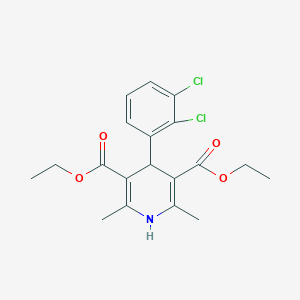


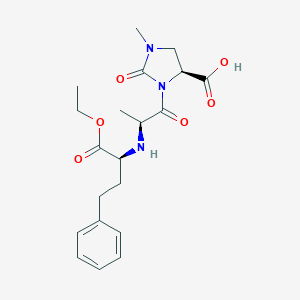
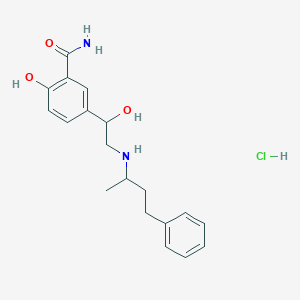
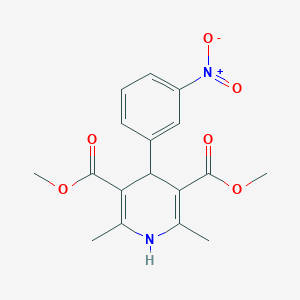
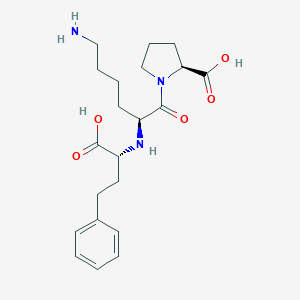



![Des[2'-(1H-tetrazol-5-yl)] 2-Cyanolosartan Carboxaldehyde](/img/structure/B193153.png)
![5-(4'-Methyl-[1,1'-biphenyl]-2-yl)-1-trityl-1H-tetrazole](/img/structure/B193154.png)


